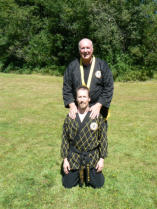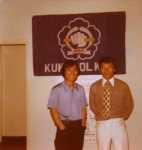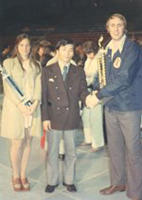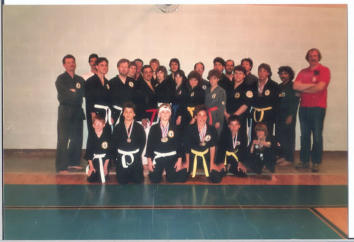

Kong Shin Bup International LLC - 7 Jasper Lane, Nashua NH 03063 - 971-645-1152 - kevin_janisse@hotmail.com

Kong Shin Bup History
Kong Shin Bup™ (Do) was founded by the late Grandmaster Pak in Shyuk. The name, “Kong Shin Bup” literally translated, means "empty body principle"; however the meaning goes much deeper and that Grandmaster Pak wished to cultivate a system using the concept of "open mind". In the West we might better interpret Kong Shin as "empty cup". The fact that Grandmaster Pak incorporated the entire old Kuk Sool Won-Hap Ki Do curriculum, added ground grappling techniques, and then added techniques of other ancient Korean arts (Tae Kyun Soo Bahk Do) seems to support this view. The "empty cup principle" allows Kong Shin Bup™ practitioners to totally focus on the end result and complete feats considered superhuman by the average lay person. This is reflected in the demanding breaking requirements of Kong Shin Bup™. As with most Korean martial arts, Kong Shin Bup practitioners have strong kicking skills. In addition to this, the style uses well over three thousand joint locking techniques -- including hundreds of ground grappling techniques not normally found in modern Korean martial art styles. Kong Shin Bup™ can be considered a Yu Kwan Sool (soft/hard) style martial art. Kong Shin Bup™ provides its practitioners with training in: acupressure healing techniques, meditation, breathing, forms, weapons, punching, kicking, throwing, archery, horseback riding, falling, acrobatics, joint locks, water techniques, pressure points, and a myriad of self-defense techniques that are totally compatible with one another. The number of years involved in the ongoing development of this art speaks of its depth. GM Pak, GM Timmerman, and GM Janisse have all invested most of their life into creating an art based on common foundational principles. A cumulative 140 years of experience can be drawn upon between them. They have taken care to see that the present curriculum of Kong Shin Bup™ is not flawed by using techniques that are not compatible with its foundational principles. The more than 3,600 Kong Shin Bup™ Hap Ki Do techniques are divided into some two hundred and seventy vulnerable areas of attack. Ki power and pressure points are used extensively. In addition to using the circular methods found in many soft style arts, Kong Shin Bup™ also employs strong linear counter attacks from a narrow, but solid, stance that does not hamper quick turns. Although Kong Shin Bup practitioners are quite capable of subduing their opponents, they are just as likely to finish an altercation with a devastating strike to a vulnerable area. In fact, this method is recommended in multiple person attacks. One could say that Kong Shin Bup™ Hap Ki Do is a carefully organized martial art blend of modern Tae Kwon Do, ancient Tae Kyun, Soo Bahk Do, and Aiki Jiu Jitsu techniques. Grandmaster Pak's extensive background in Kuk Sool Hap Ki Do can readily be seen in Kong Shin Bup™, and the influence of occupation forces from China and Japan are quite evident; however, the art is quite unique in the manner in which these influences are blended with ancient Korean martial arts. We are proud to continue Grandmaster Pak's vision of Kong Shin Bup™, and we do so with the "open mind" he stressed.Kong Shin Bup
What is Kong Shin Bup?
This is a Hap Ki Do based system developed to provide practitioners a diversified system of Korean Martial Arts focused primarily on Military style defensive and offense fighting. The late Grandmaster Pak, In Shuk developed this system for the purpose of ending a fight or confrontation quickly and efficiently. Before Grandmaster Pak died he passed on the art to Grandmaster Rudy Timmerman. In 2014 Grandmaster Timmerman passed on the art to Grandmaster Kevin Janisse. The requirements for promoting in Kong Shin Bup HapKiDo are very strict and demanding. Students serious about obtaining practical and usable skills for protecting themselves and their loved ones have found this art to provide a life long journey of learning.The Arts We Practice
The Roots our Martial Art is based on are the three
main influences in martial art history: Sado Mu Sool
(Tribal Martial Arts), Bul Kyo Mu Sool (Buddhist
Martial Arts) and Koong Joong Mu Sool (Royal Court
Martial Arts). Although only recently developed, Kong
Shin Bup™ techniques are based on roots thousands
of years old, and it incorporates three main segments
of martial arts to form a martial art system rather
than a style.
Sado Mul Sool, of tribal martial arts are likely to be
the first organized martial arts developed in order to
provide food for the families, clans, of tribes the
world over. Later, as agriculture developed, it became
necessary to defend crops and territory. Since nature
has a way of allowing the strong and skillful to
survive, the honing of skills must have been the
number one priority for all tribes. It is from these
finely honed skills that Our art takes the many "empty
hand" and simple weapons techniques.
Bul Kyo Mu Sool are the unique skills developed by
Korean Buddhist Monks. In his travels to spread his
religion, the Monk Bodhid Dharma recognized that
many hours of sitting in quiet meditation created a
need for some form of exercise to maintain health. In
addition, traveling was a hazard due to highwaymen
and robbers. Monasteries the world over are the
birthplace of many inventions, and it is widely
believed that Bhodhid Dharma developed a series of
exercises that form the basis of Bul Kyo Mul Sool. The
famous Shaolin Monks are an example of his
influence. Meditation, acupressure points, the study
of animal fighting techniques, and special "KI"
breathing techniques are among some of the
influences our art has borrowed from Bul Kyo Mu
Sool. For training purposes, practitioners use low,
narrow stances that develop great balance and strong
legs. In turn, this aids students in acrobatics, high
kicking and jumping skills.
Koong Joong Mul Sool techniques include the use of
weapons not commonly available to commoners. Just
as our government today restricts us from owning
advanced weapons, the ancient courts of Korea
restricted the use of weapons to its citizens. In order
to provide a more complete art to our students, Kong
Shin Bup includes the skills normally reserved for
members of the Korean Royal Court guard. Some of
the weapons Kong Shin Bup students use include, but
not limited to, the Sword, Short and long staff,
Belt/Rope, Fan, Knive, Spear, and rope staff.
Caution! Whenever techniques are influenced by
various martial art foundations, it is essential that the
fundamentals of these techniques are compatible.
For instance, a circular art is difficult to practice when
using the strong wider stances of a linear art -- it is
better suited to redirect the opponents power by
using a narrow and more mobile stance. To mix these
two basic principles would confuse most students.
Some students prefer strong wide stances, others
prefer lower and narrower stances. We suggest that
each student finds a martial art that is best suited to
their natural ability to compliment their God given
spirit.
Kong Shin Heritage
Grandmaster Pak, In Shyuk was born in 1938, and was a graduate of Dong Kuk University where he studied Buddhist Philosophy, as well as Psychology. A contemporary of Suh, In Hyuk, and Lee, Joo Bang, Grand Master Pak visited many temples and monasteries throughout his life to learn and train. He also studied under Hapkido founder Choi, Yong Sul. Before the days of Kuk Sool Won, Pak In Shyuk, Suh In Hyuk and other Korean masters were partners in a martial arts movement known as Kuk Sool Hapkido; several masters were sent out from Korea to promote this art abroad, Pak In Shyuk was one of them. Arriving in Canada during the 1960's he opened his first North American dojang in Sault Ste. Marie, Ontario in 1967. During this time Pak In Shyuk vigorously promoted the Kuk Sool Hapkido system, the certification he used was issued in Korea, signed by Suh In Hyuk, and then countersigned by himself. Eventually, a split occurred among the masters of Kuk Sool Hapkido, and several went there own ways. Suh In Hyuk continued by founding the Kuk Sool Won, teaching the Kuk Sool Hapkido system, along with his own unique knowledge and training. Likewise, Pak In Shyuk founded Kong Shin Bup, which translates as "Open Body Method" or open mind style. Pak In Shyuk passed this art on to Master Rudy Timmerman of Canada, and eventually founded another art which he called Tae Geuk Do. Master Pak In Shyuk died in 1995 due to heart failure. Grandmaster Timmerman continued to teach Kong Shin Bup to Kevin Janisse even during the days of being associated with the World Kuk Sool Won Association. After leaving the WKSA Grandmaster Timmerman focused his attention spreading Kong Shin Bup along with the assistance of Kevin Janisse. In August of 2014 Grandmaster Kevin Janisse was named as the sole inheritor of the Art of Kong Shin Bup.



1986 Kong Shin Bup Class with Grandmaster
Rudy Timmerman far right and Grandmaster
Kevin Janisse, back row left side.


Kong Shin Bup International LLC - 7 Jasper Lane, Nasua NH 03063 - 971-645-1152 - kevin_janisse@hotmail.com

Kong Shin Bup History
Kong Shin Bup™ (Do) was founded by the late Grandmaster Pak in Shyuk. The name, “Kong Shin Bup” literally translated, means "empty body principle"; however the meaning goes much deeper and that Grandmaster Pak wished to cultivate a system using the concept of "open mind". In the West we might better interpret Kong Shin as "empty cup". The fact that Grandmaster Pak incorporated the entire old Kuk Sool Won-Hap Ki Do curriculum, added ground grappling techniques, and then added techniques of other ancient Korean arts (Tae Kyun Soo Bahk Do) seems to support this view. The "empty cup principle" allows Kong Shin Bup™ practitioners to totally focus on the end result and complete feats considered superhuman by the average lay person. This is reflected in the demanding breaking requirements of Kong Shin Bup™. As with most Korean martial arts, Kong Shin Bup practitioners have strong kicking skills. In addition to this, the style uses well over three thousand joint locking techniques -- including hundreds of ground grappling techniques not normally found in modern Korean martial art styles. Kong Shin Bup™ can be considered a Yu Kwan Sool (soft/hard) style martial art. Kong Shin Bup™ provides its practitioners with training in: acupressure healing techniques, meditation, breathing, forms, weapons, punching, kicking, throwing, archery, horseback riding, falling, acrobatics, joint locks, water techniques, pressure points, and a myriad of self-defense techniques that are totally compatible with one another. The number of years involved in the ongoing development of this art speaks of its depth. GM Pak, GM Timmerman, and GM Janisse have all invested most of their life into creating an art based on common foundational principles. A cumulative 140 years of experience can be drawn upon between them. They have taken care to see that the present curriculum of Kong Shin Bup™ is not flawed by using techniques that are not compatible with its foundational principles. The more than 3,600 Kong Shin Bup™ Hap Ki Do techniques are divided into some two hundred and seventy vulnerable areas of attack. Ki power and pressure points are used extensively. In addition to using the circular methods found in many soft style arts, Kong Shin Bup™ also employs strong linear counter attacks from a narrow, but solid, stance that does not hamper quick turns. Although Kong Shin Bup practitioners are quite capable of subduing their opponents, they are just as likely to finish an altercation with a devastating strike to a vulnerable area. In fact, this method is recommended in multiple person attacks. One could say that Kong Shin Bup™ Hap Ki Do is a carefully organized martial art blend of modern Tae Kwon Do, ancient Tae Kyun, Soo Bahk Do, and Aiki Jiu Jitsu techniques. Grandmaster Pak's extensive background in Kuk Sool Hap Ki Do can readily be seen in Kong Shin Bup™, and the influence of occupation forces from China and Japan are quite evident; however, the art is quite unique in the manner in which these influences are blended with ancient Korean martial arts. We are proud to continue Grandmaster Pak's vision of Kong Shin Bup™, and we do so with the "open mind" he stressed.Kong Shin Bup
What is Kong Shin Bup?
This is a Hap Ki Do based system developed to provide practitioners a diversified system of Korean Martial Arts focused primarily on Military style defensive and offense fighting. The late Grandmaster Pak, In Shuk developed this system for the purpose of ending a fight or confrontation quickly and efficiently. Before Grandmaster Pak died he passed on the art to Grandmaster Rudy Timmerman. In 2014 Grandmaster Timmerman passed on the art to Grandmaster Kevin Janisse. The requirements for promoting in Kong Shin Bup HapKiDo are very strict and demanding. Students serious about obtaining practical and usable skills for protecting themselves and their loved ones have found this art to provide a life long journey of learning.The Arts We Practice
The Roots our Martial Art is based on are the three
main influences in martial art history: Sado Mu Sool
(Tribal Martial Arts), Bul Kyo Mu Sool (Buddhist
Martial Arts) and Koong Joong Mu Sool (Royal Court
Martial Arts). Although only recently developed, Kong
Shin Bup™ techniques are based on roots thousands
of years old, and it incorporates three main segments
of martial arts to form a martial art system rather
than a style.
Sado Mul Sool, of tribal martial arts are likely to be
the first organized martial arts developed in order to
provide food for the families, clans, of tribes the
world over. Later, as agriculture developed, it became
necessary to defend crops and territory. Since nature
has a way of allowing the strong and skillful to
survive, the honing of skills must have been the
number one priority for all tribes. It is from these
finely honed skills that Our art takes the many "empty
hand" and simple weapons techniques.
Bul Kyo Mu Sool are the unique skills developed by
Korean Buddhist Monks. In his travels to spread his
religion, the Monk Bodhid Dharma recognized that
many hours of sitting in quiet meditation created a
need for some form of exercise to maintain health. In
addition, traveling was a hazard due to highwaymen
and robbers. Monasteries the world over are the
birthplace of many inventions, and it is widely
believed that Bhodhid Dharma developed a series of
exercises that form the basis of Bul Kyo Mul Sool. The
famous Shaolin Monks are an example of his
influence. Meditation, acupressure points, the study
of animal fighting techniques, and special "KI"
breathing techniques are among some of the
influences our art has borrowed from Bul Kyo Mu
Sool. For training purposes, practitioners use low,
narrow stances that develop great balance and strong
legs. In turn, this aids students in acrobatics, high
kicking and jumping skills.
Koong Joong Mul Sool techniques include the use of
weapons not commonly available to commoners. Just
as our government today restricts us from owning
advanced weapons, the ancient courts of Korea
restricted the use of weapons to its citizens. In order
to provide a more complete art to our students, Kong
Shin Bup includes the skills normally reserved for
members of the Korean Royal Court guard. Some of
the weapons Kong Shin Bup students use include, but
not limited to, the Sword, Short and long staff,
Belt/Rope, Fan, Knive, Spear, and rope staff.
Caution! Whenever techniques are influenced by
various martial art foundations, it is essential that the
fundamentals of these techniques are compatible.
For instance, a circular art is difficult to practice when
using the strong wider stances of a linear art -- it is
better suited to redirect the opponents power by
using a narrow and more mobile stance. To mix these
two basic principles would confuse most students.
Some students prefer strong wide stances, others
prefer lower and narrower stances. We suggest that
each student finds a martial art that is best suited to
their natural ability to compliment their God given
spirit.
Kong Shin Heritage
Grandmaster Pak, In Shyuk was born in 1938, and was a graduate of Dong Kuk University where he studied Buddhist Philosophy, as well as Psychology. A contemporary of Suh, In Hyuk, and Lee, Joo Bang, Grand Master Pak visited many temples and monasteries throughout his life to learn and train. He also studied under Hapkido founder Choi, Yong Sul. Before the days of Kuk Sool Won, Pak In Shyuk, Suh In Hyuk and other Korean masters were partners in a martial arts movement known as Kuk Sool Hapkido; several masters were sent out from Korea to promote this art abroad, Pak In Shyuk was one of them. Arriving in Canada during the 1960's he opened his first North American dojang in Sault Ste. Marie, Ontario in 1967. During this time Pak In Shyuk vigorously promoted the Kuk Sool Hapkido system, the certification he used was issued in Korea, signed by Suh In Hyuk, and then countersigned by himself. Eventually, a split occurred among the masters of Kuk Sool Hapkido, and several went there own ways. Suh In Hyuk continued by founding the Kuk Sool Won, teaching the Kuk Sool Hapkido system, along with his own unique knowledge and training. Likewise, Pak In Shyuk founded Kong Shin Bup, which translates as "Open Body Method" or open mind style. Pak In Shyuk passed this art on to Master Rudy Timmerman of Canada, and eventually founded another art which he called Tae Geuk Do. Master Pak In Shyuk died in 1995 due to heart failure. Grandmaster Timmerman continued to teach Kong Shin Bup to Kevin Janisse even during the days of being associated with the World Kuk Sool Won Association. After leaving the WKSA Grandmaster Timmerman focused his attention spreading Kong Shin Bup along with the assistance of Kevin Janisse. In August of 2014 Grandmaster Kevin Janisse was named as the sole inheritor of the Art of Kong Shin Bup.



1986 Kong Shin Bup Class with Grandmaster
Rudy Timmerman far right and Grandmaster
Kevin Janisse, back row left side.











































